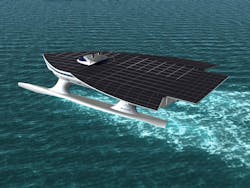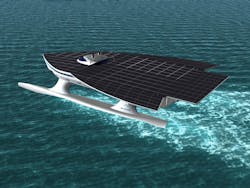We have covered several solar panel applications and I just found a new one: the MS Tûranor PlanetSolar, the world's largest solar-powered boat. It was the first boat to circumnavigate the world powered exclusively using solar energy. It docked on May 4, 2012, after sailing for 584 days and travelling over 60,000 km.
This initial version of the solar boat is a 31-meter three-hull catamaran. Its deck has over 500 square meters of 18.8% efficient solar panels rated 93 kW. Panels charge 648 series and parallel connected lithium-ion batteries that produce 388 V and 2910 Ah. The batteries power two 10kW (maximum), 1000 rpm permanent magnet synchronous motors in each hull. The boat's shape allows it to reach speeds up to 14 knots. Its carbon fiber composite hull was model tested in wind tunnels and was tank tested to determine its hydrodynamics and aerodynamics. Construction cost was 12.5 million Euros. Its name was derived from J.R.R. Tolkien's novel The Lord of the Rings, which translates to "The Power of the Sun."
Its two years of solar circumnavigation were instructive for PlanetSolar and led to an initial assessment of the vessel’s performance. This assessment indicated where optimizations were needed to make the boat more efficient and maneuverable. These improvements will expand and diversify the boat’s applications and uses; notably, enabling it to navigate to the northernmost part of the Atlantic, near the Artic, for the first time.
It recently went to sea with a team of scientists who will monitor the air and water of the Atlantic Ocean's Gulf Stream, a current that influences the climates of North America's east coast and Europe's west. The team of scientists will monitor ocean phenomena such as eddies and whirlpools that, in the right environment, help to power the so-called ocean conveyor belt that drives circulation in the oceans.
This new four-month scientific expedition will take the Tûranor out of the Mediterranean headed toward Miami, Florida, at the southwestern tip of the Gulf Stream. From there, physicists, biologists and climatologists from the University of Geneva, led by Professor Martin Beniston, director of the Institute of Environmental Sciences at the university, will begin continuous monitoring of the air and water in a project dubbed PlanetSolar Deep Water.
Built in Kiel, Germany, the catamaran runs exclusively on solar energy. After two years of design and construction, PlanetSolar was responsible for many technological advances, notably in the domain of composite material manufacturing and solar energy storage.
In preparation for its 2013 expedition, the MS Tûranor PlanetSolar underwent major maintenance upgrades. Among the extensive maintenance tasks and optimizations carried out, most notable was the cabin refurbishment, the creation of a walkway on the solar bridge, an increase in water tank capacity, and improvement to the rudder. The most significant optimization was a change to the propulsion system — replacing the surface propellers with a completely immerged system.
This project is under the direction of the University of Geneva, Switzerland. Founded in 1559, the University of Geneva (UNIGE) ranks among the top 100 universities in the world. UNIGE welcomes approximately 16,000 students each year to its eight colleges, dealing with the essential domains of science, medicine, literature, economic and social sciences, law, theology, psychology, education, translation, and interpretation sciences. UNIGE has three missions: education, research, and service to the community. Additionally, UNIGE has been a member of the League of European Research Universities (LERU) since 2002.
About the Author

Sam Davis Blog
Editor-In-Chief - Power Electronics
Sam Davis was the editor-in-chief of Power Electronics Technology magazine and website that is now part of Electronic Design. He has 18 years experience in electronic engineering design and management, six years in public relations and 25 years as a trade press editor. He holds a BSEE from Case-Western Reserve University, and did graduate work at the same school and UCLA. Sam was the editor for PCIM, the predecessor to Power Electronics Technology, from 1984 to 2004. His engineering experience includes circuit and system design for Litton Systems, Bunker-Ramo, Rocketdyne, and Clevite Corporation.. Design tasks included analog circuits, display systems, power supplies, underwater ordnance systems, and test systems. He also served as a program manager for a Litton Systems Navy program.
Sam is the author of Computer Data Displays, a book published by Prentice-Hall in the U.S. and Japan in 1969. He is also a recipient of the Jesse Neal Award for trade press editorial excellence, and has one patent for naval ship construction that simplifies electronic system integration.

